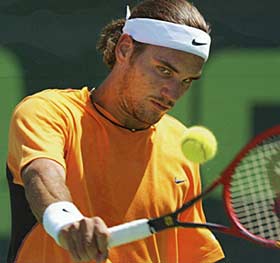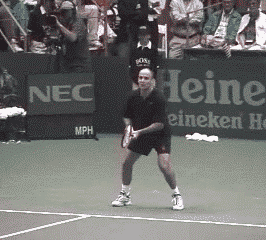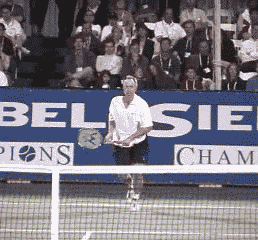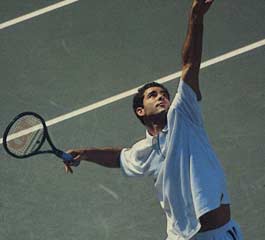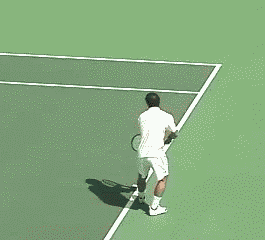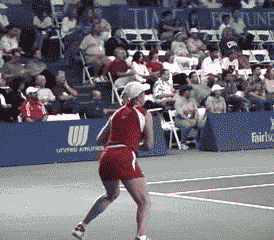|
TennisOne Lessons The Last Three Fingers of the Hitting Hand
The last three fingers of your hitting hand may very well be the key to success in tennis! One of the most common questions I hear from my students is, "How hard should I squeeze the racquet on my (Insert name of stroke)?" Part of the problem I have with this question is the implication that someone has to squeeze "hard" at all because the more tense you become physically, the more difficult it is to play tennis! All great athletes play with a relaxed focus. That is, during competition, while they are intense mentally, they remain very relaxed physically. Excess tension can interfere with every aspect of your tennis game from movement to stroke patterns. Did you ever see Michael Jordan play basketball while being physically tense? Furthermore, the squeeze of the racquet only needs to occur right before, during, and after contact. Many tennis players suffer from arm, hand, and or, wrist fatigue during a match because they are squeezing hard all the time instead of only when they are about to hit the ball. There is no reason to be holding the grip tightly when the ball is on your opponent's side of the net. The phrase I like to use is, "Be firm but flexible." However, simply saying this phrase doesn’t necessarily mean someone will understand how it applies to their tennis game. This is where the last three fingers of the hitting hand comes into play.
Anatomically, the strength of the wrist is in the last three fingers of the hand. Over the years I have given numerous tennis lessons to physicians who specialize in the hand/wrist and they have confirmed this fact. Yet, how do many tennis players create grip strength? They squeeze primarily with their thumb and index finger or their entire hand. A very simple exercise demonstrates the role the last three fingers have: Take a racquet in your hitting hand and while keeping the thumb and index finger off the grip, gently squeeze the last three fingers. You will immediately feel the firmness in your wrist. Now, gently wrap the thumb and index finger around the grip and keep the last three fingers off the grip and you will immediately feel the relaxation in your wrist. One of the great benefits of utilizing the last three fingers on the hitting hand during play is that the results are immediate and can often solve many problems. Let’s take a look at how this concept works on individual strokes: Groundstrokes By squeezing the last three fingers on the hitting hand there will be immediate help solving some of these common problems:
Note: Obviously, with a two-handed backhand there is more initial support than with a one-handed backhand regardless of how the last three fingers are used. However, many two-handed players also squeeze much too hard with both hands rather than learning how to use the fingers on each individual hand. Whether you are too tense on a one-handed backhand or two-handed backhand, the results will often be the same…”Tight” swings, arm, hand, and or wrist fatigue, “pushing” the ball, and so on. Timing note: As to what moment the squeezing of the last three fingers should occur, again, as noted above, it should be just prior to contact. If you squeeze too early, you might find it difficult to adjust for a ball that bounces differently than you anticipated. If you squeeze too late, you will not benefit from the use of the last three fingers. Return of Serve The benefits are nearly identical to the ground stroke. Yet specific to the return of serve, two of the most common challenges are when facing a powerful serve and/or one with lots of spin. A typical reaction for many tennis players in these situations is to simply squeeze harder with the entire hand (which tends to make the arm more tense) to counter the power or spin. Instead, focus only on squeezing the last three fingers just prior to contact. This will provide the firmness needed and yet keep the hand and wrist relaxed enough to be able to adjust to variables i.e., a serve that bounces differently than anticipated. Another challenging situation is when you are forced to move laterally (wide) to return a serve. By squeezing the last three fingers you give yourself the benefit of some firmness but at the same time allow for the flexibility which is needed to handle balls when the hitting arm is fully extended. To understand this concept, try hitting a wide shot with a locked arm, elbow, and wrist?!
Volley The benefits on the volley are very similar to the ground stroke and return of serve. Additionally, with the volley, since the ball is being contacted in the air without first bouncing, the force of the impact will be greater. So the squeeze may need to be a little more firm. This concept also works well for two common situations which often challenge even the best tennis players:
Serve The key to a good serve is having a relaxed hand and wrist, just like the motion used when throwing a ball. Therefore on the serve, the last three fingers need to be relaxed during contact in order to maximize use of the hand and wrist. To understand this concept, take a ball in your racquet hand; squeeze it as hard as you can and while squeezing try to throw it!? The tension in your hand makes throwing difficult. Yet many tennis players squeeze too hard with their racquet hand while serving and the result is a loss of power.
One way to ensure the hitting hand is relaxed is to start that way! In the ball tossing hand, put the ball between the thumb and index finger while supporting the racquet head with the last three fingers. Now the hitting hand can relax on the grip as the motion begins and continues through contact. You should be able to feel the difference. Simple Drills to Do Emphasizing the Last Three Fingers Serve Practice serving with the bottom one or two fingers on your hitting hand off the grip. Slide your hitting hand down the grip so the bottom one or two fingers are below the butt cap. This will give you the best feeling the role your fingers and wrist play in hitting a good serve. Sometimes just practicing throwing balls is a good first step before putting the racquet in your hand. Ground Strokes and Return of Serve Hit these shots while your thumb and index finger are off the grip. While hitting, practice applying different degrees of pressure with the last three fingers to better understand the “firm but flexible” concept. As you progress, practice keeping your entire hand relaxed on the grip until just prior to contact, then squeeze the last three fingers. Relax the hand again afterwards. Volley You can do the same drill as for ground strokes and return of serve. For those two-handed backhand players who feel “weak” when forced to hit a one-handed backhand volley, begin by hitting a moderately paced ball, then as you become more comfortable, increase the speed of the incoming ball.
Special Note to Two-Handed Players As someone with a one-handed backhand, I'm almost never forced to hit a two-handed shot; but two-handed players are sometimes forced to hit one-handed shots. - a low or wide volley, a wide return of serve, and when out of position and forced to hit on the run to name a few examples. Therefore, I always encourage my students with two-handed shots to practice hitting one-handed in those situations. The first thing I show them is how to squeeze the last three fingers to counter their feeling of not being strong enough. This approach also works well for someone wanting to transition from a two-handed backhand to a one-handed backhand. While seemingly a fairly simple technique, squeezing your last three fingers (or relaxing them on the serve) can pay huge dividends with your tennis! Your comments are welcome. Let us know what you think about Dave Kensler's article by emailing us here at TennisOne.
Dave Kensler has 23 years of teaching experience with Peter Burwash International (PBI), the most successful international tennis management company. PBI directs tennis programs at 60+ exclusive resorts and clubs in 23 countries and has taught over 3 million students in their 30 year history. For information on PBI tennis destinations and employment opportunities please go to www.pbitennis.com. All PBI Tennis Professionals play with WILSON racquets and wear WILSON shoes. |

